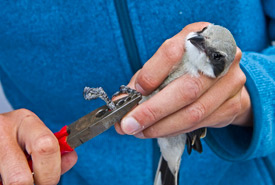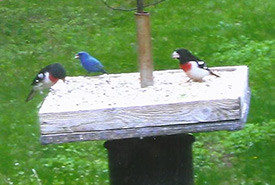Something's Fishy: The good, the bad and the goby

Round goby (Photo by Peter van der Sluijs/Wikimedia Commons)
Think of the meanest, toughest fish in a Canadian river. The one other species actively avoid, swimming faster as it approaches. Is it the longnose gar, with its mouth full of sharp teeth? Or the largemouth bass, a species which devours its prey...
Reptiles and amphibians of the Happy Valley Forest

Red eft (the immature form of the spotted newt) are the commonest reptile in the Happy Valley Forest and crowd the forest trails during egg-laying time. (Photo by Dr. Henry Barnett)
The reptile species in the Happy Valley Forest number 19. The area provides one of the last redoubts for the threatened Jefferson’s salamander. Red efts are common, red-backed and spotted salamanders will be regularly seen in the but the...
The Traills at Rice Lake

A view of the former home of Canadian author Catharine Parr Traill taken on Friday, September 19, 2014 on Smith Rd. in Lakefield. (Photo by Clifford Skarstedt/Peterborough Examiner/QMI Agency)
Ontarians usually associate Catharine Parr Traill with her book, The Backwoods of Canada. Those backwoods were located near Lakefield where she and her husband Thomas first pioneered on land just to the south of what is now Lakefield College...
Mammals of the Happy Valley Forest

White-tailed deer thrive in Happy Valley Forest wintering in the Hemlock areas of relatively less snow. (Photo by Dean Mullin)
In the wintertime the mammals are the most conspicuous form of life in the forest. The largest is the white-tailed deer, of which as many as nine have appeared below our feeder. Squirrels are the commonest mammal, with the black and its colour...
Something's Fishy: The old fish and the lake

Juvenile bowfin from Ontario waters (Photo by Raechel Bonomo/NCC Staff)
What if I told you there are living fossils swimming in our waters right now? A few fish species that inhabit Canadian lakes and rivers have such ancient lineages, they are considered prehistoric. Some of these species swam alongside the...
How to set a river free

Just add water. Newly opened natural bypass channel! (Photo by NCC)
Perseverance is stubbornness with a purpose. It’s what river lovers need to remove a dam, and set a river free. Luckily for a beautiful trout stream that feeds into the Noisy River near Creemore, Ontario, the Nature Conservancy Canada (NCC)...
Something's Fishy: Ghosts of fishes past

A 60-day-old American paddlefish (Polyodon spathula) fry (Photo from Wiki Commons)
They’re there, lurking the depths of Canadian lakes and rivers, unseen by humans or other fishes. Ghosts of fishes extirpated or extinct from waters across Canada haunt other species and scientists alike. Their absence leaves an impression...
Strength in numbers: Captive breeding and release program for shrikes in Ontario

All of the young shrikes are banded with a uniquely-numbered metal band before they are released; most will also get a combination of colour bands so they can be easily identified from a distance in the wild. (Photo by Lydia Dotto, ImageInnovation Photography)
There are only a few places left in Ontario where you can reliably find the endangered loggerhead shrike; one of those places is a property owned by the Nature Conservancy of Canada (NCC). NCC’s Scheck Nature Reserve, located northeast of...
Cave diving in the Ottawa River, Canada

Dressed and ready to enter the water - note the yellow loggers on my right. (Photo by Cheryl Buzzacott)
Before coming to Canada I contacted renowned Canadian cave diver David Sawatzky, whom I knew had mapped these caves in the 1990s before moving to Nova Scotia. David kindly sent me his detailed map and some background information, including that...
Birds of the Happy Valley Forest (Part Two)

Two species commonly sharing the feeder: rose-breasted grosbeak and male indigo bunting. These and the oriole represent the greatest beauties in the forest. (Photo by Dr. Henry Barnett)
Summer birds There is plenty of sound in the Happy Valley Forest, from the summering birds throughout the day and the woods only quiet down from September to late March. Some usually mid-southern birds have reached the Moraine to live. I can...

